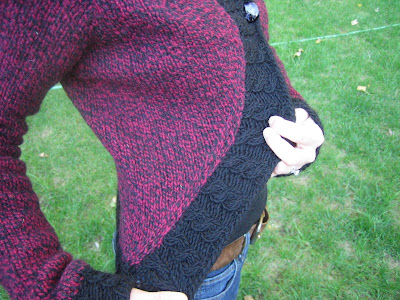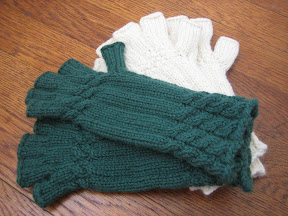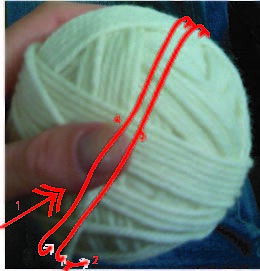I finished the shrug! (click on the link for some of the background of the yarn and how I got started with the pattern.) It's more like a sweater now because it is actually long enough to reach my waist and I love it! I can't believe how closely the finished product matches my sketches and imaginings of how I wanted it to end up. The first two drawings are ones I made during a meeting at work, the 3rd is the schematic I used to design the pattern and make the sweater.



I actually finished the sweater nearly two weeks ago, uploaded the pictures last week, and found my sketches tonight....yay for being organized - they were unexpectedly in the very bag I'd used for this project and right where I'd left them under a gigantic pile of laundry.


yarn: 1) I started with 497 grams of the licorice twist (I made up this name - I have no idea what the original colorway was called) from Briggs and Little Woolen Mills and have 192 grams left. 2) I used an entire skein of Lamb's Pride Worsted which is 113 grams and 173 meters for the black border. Funnily enough, while I have quite a bit of the licorice twist left, I had about a yard of the black left when I cast of the ~450 stitch main border....I was weighing the skein every row to figure out how wide I'd be able to make the border.
needles: Addi Turbo size 10 (6mm) 32" and some size 10 (6mm) 8" dpns. It was quite interesting to make the approximately 60" border on 32" needles. I scrunched all the stitches together and did some cursing as I lifted the entire sweater around and around and slid the stitches down the right side and up the left side. I did acquire some cheap size 10 plastic needles about halfway through but they were also 32" so each row, I alternated which needles I was using to make at least half the stitches easier to knit.
button: I got the button at the Fingerlakes fiber festival and it is perfect for the sweater. I made the button hole in the border by casting off 2 stitches and casting them on the next row. It stretched out a lot until I whip stitched around the hole with the same yarn to strengthen it.

Things I learned making this sweater:
1) the raglan construction doesn't look so nice with a different color border knitted on - maybe I can make a yoke next time so it doesn't look so square where the black border is knitted into the raglans.
2) When I think I'm going to run out of yarn and buy more, I will not actually run out of yarn.
3) The power of the scale is awesome - for the border I was using about 6 grams of yarn per plain round about about 7 per cabled round. When I had 45 grams left, I figured I could knit 6 more rows and still have enough for the bind off. It actually worked. The bind off used almost two rows worth of yarn which I will certainly keep in mind next time.
4) I never used to understand why anyone would make pieces of a garment flat, then sew them together - it seemed like an extra step and kinda confused me. When I look at a sleeve knitted flat, it doesn't look like it will go on my arm - when I'm knitting a sleeve in the round, I can try it on as I go. When I'm knitting seamless, I have almost no ends to weave in, and fewer stitches to pick up since I also used figure 8 cast-ons everywhere. Somehow, I derive extra pleasure from not having any seams in the garment. I began to understand why someone might knit a garment flat when I was working on the sleeves - every 3 or 4 rounds, I'd have to pick the whole sweater up and untwist it. It was still nice not having to pin the sleeve in place and sew it to the shoulder wondering if I was doing it right or if I'd have to try again and again...
5) this is the worst - I'm ALLERGIC to mohair. I had no idea. It didn't bother me when I swatched, it didn't bother me when I was carrying the mohair around to look at it, it didn't bother me when I knit the cuffs. It began to bother me about halfway through the border (the same time I was panicking about running out of yarn and obsessively weighing the remaining skein). I actually had to stop knitting, wash my hands, wash my face, take out my contacts, and swallow some claritin. Then I finished knitting after I took a walk. I wore it to work the next day because it was almost cold and I was excited about my new sweater. I had to take it off on 3 or 4 separate occasions because my eyes were too itchy. I've washed it, but I think I'm still allergic - either my eyes are itching thinking about it, or they're itching because I moved it to make room for clean laundry a little bit ago.
I can't quite face re-knitting the border just yet, I like it too much to give it away to someone my size with no mohair allergy, and I don't really see the point of owning a sweater that lives unworn in my attic.
I want to destroy the 15% mohair in the border. I love the border. It's perfect. I can't believe I figured out the right number of stitches to pick up for each separate section of the sweater, I can't believe I counted to 450, and I can't believe my border lies flat on the first try. Maybe when it gets really cold, I can take a lot of claritin, avoid touching my eyes, and wear it anyway.
The shrug that morphed into a sweater was in fact a success. I'm planning to make one for my sister - she's smaller than me so I think I can get the entire sweater and border from her 4 skeins of Briggs and Little wool.
I've never really written a pattern before - I take notes for myself to make something again later but that's about it. I'm pretty sure my notes wouldn't make sense to anyone but me and of course, they're only in my size. However, if enough (more than 10) people are interested in a seamless sweater/shrug and leave a comment telling me so, I'd consider doing some math and writing it up for a few sizes.
happy knitting!
I originally posted this on my other blog stringtheories.wordpress.com


























